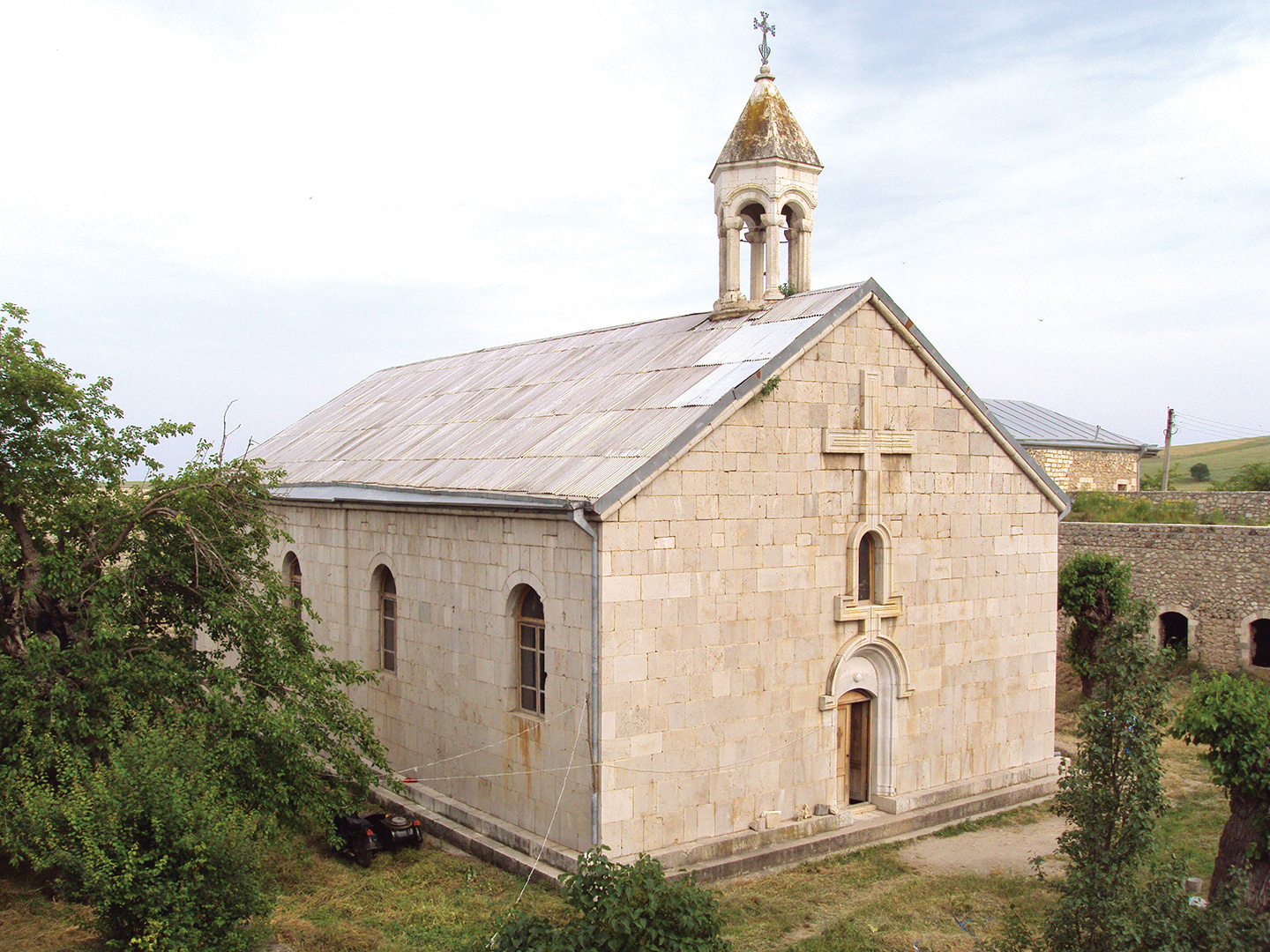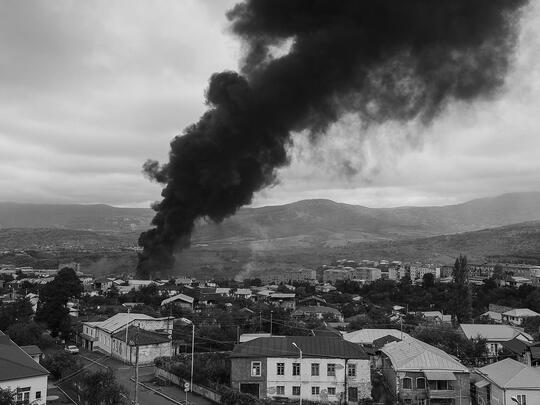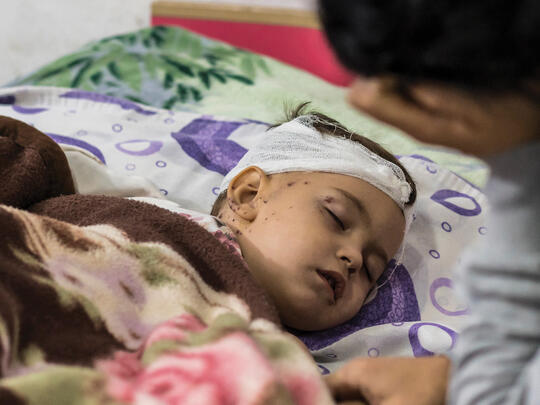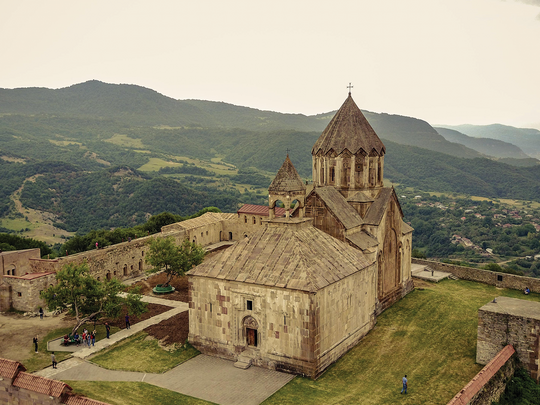On October 8, Ghazanchetsots Cathedral in Artsakh’s cultural city of Shushi was severely damaged following shelling from the Azeri army in yet another effort to obliterate Armenian culture and heritage. The historic monastery has fallen victim to ethnic violence before, requiring volunteer restoration efforts.
More than 4,000 standing, mostly ancient Armenian monasteries have withstood various battles, Persian rule, Arab domination, a massacre by the Turks in 1894, the 1915 Armenian Genocide, and now, the atrocities facing Artsakh. It’s no coincidence that most of these ancient monuments are nestled on highlands; Armenian monasteries were built to protect against attacks, but as events old and new have shown, this has offered little immunity.
If these stone walls could talk, they would not only tell the story of the Armenians but also of world civilization itself, starting with the Ghazanchetsots Cathedral and other illustrious sites in imminent need of international protection.

The Monasteries of Artsakh
Gandzasar was constructed in Mardakert, Artsakh between the 10th and 13th centuries. Not unfamiliar to attacks, the monastery had fallen victim to prior Azerbaijani aggression in the early 1990s, causing damage to buildings within the complex. The monastery was saved and rebuilt with pride by Armenians. It is considered a symbol of Artsakh and its enduring people.
Its iconic umbrella-style roof tops the masonry dome, relief sculptures garnish the grounds, and historical inscriptions fill its walls. The monastery is home to relics tracing back to St. John the Baptist and St. Zechariah, making it a valued site for Christianity, not only the Armenian Apostolic Church.
Perhaps the second most recognized monastery is that of Amaras. Credited as one of the oldest Christian monuments in Armenia and Artsakh, it was founded by St. Gregory the Illuminator in the 4th century and is widely recognized to have housed a school founded by Mesrob Mashtots, and the first usage of the Armenian alphabet. The ancient ground, which notably holds the burial place of Saint Grigoris (the grandson of Saint Gregory the Illuminator) is said to be of the oldest, surviving Armenian funerary construction. Not yet shielded from persecution, Amaras was wrecked by Persians and Arabs twice and was used by Russian imperial troops as a fortress. It returned to the hands of the Armenian Apostolic Church in the mid-1800s, reconstructed and maintained since. When examining the history of the Amaras Monastery, one can understand the true significance of its location at the crossroads of many battles and empires through centuries.
These are but small examples of the immense damage and disrespect that Armenian holy sites have sustained over the span of time, while the world passively observed at a distance. Thousands more have quietly been erased through much less violent tactics at the hand of the Turks.
Silent Destruction
Prior to the 1915 Genocide, records indicate more than 2,000 Armenian monasteries on what is now Turkish land. Today, less than 35 remain open and operating as intended. When discussing war crimes committed during the Genocide, we often discuss the loss of Armenians and less adequately the intentional removal of the Armenian presence. Armenian monasteries, which bore witness to millennia of baptisms, weddings, and funerals, while doubling as sanctuaries and schools, have now been camouflaged as mosques, stables, tobacco warehouses and more, in continued efforts to obliterate any traces of Armenian civilization.

Thousands of years later, these historically and religiously significant monuments continue to absorb enemy blows with little international care or support. This points to the larger truth that the precious Armenian monasteries still standing today are in dire need of international protection. Most of these wondrous triumphs of architecture and heritage surely qualify for legal protection per the United Nations Educational, Scientific and Cultural Organization (UNESCO), in addition to other international bodies such as the World Monument Fund, the International Consortium of Museums, the International Council on Monuments and Sites (ICOMOS) Blue Shield, and the Aliph Foundation.
Yet these treasures remain defenseless, save the three sites currently on the UNESCO World Heritage list. It is but a fraction of all the jewels of the Armenian inheritance that extend far beyond the borders of Armenia, but can be found in Asia and far-flung locations that speak to the Armenian international presence and influence throughout the ages.
A Case for World Recognition
In the last 25 years, UNESCO has listed three Armenian churches and monasteries on its list of World Heritage Sites, each receiving this special status between 1996 and 2000. The first to receive this recognition are the monasteries of Haghpat and Sanahin.
Dating back to the 10th-13th centuries, these ancient, rumored-to-be rival monasteries located in the Lori region of Northern Armenia are nestled in clear view of one another. Beyond serving as significant religious centers, they were also educational hubs focused on literature, medicine, and art. Both showcase impressive architectural advances through a blending of “...Byzantine ecclesiastical architecture and the traditional vernacular architecture of the Caucasian region,” as described by UNESCO. The unique architectural elements of the two monasteries, paired with its universal value and surrounding environmental threats are what earned the important protection under the UNESCO World Heritage Zone.

Built in Armenia’s Upper Azat Valley between the 4th and 13th centuries, Geghard’s most impressive architectural boast is that most of the monasteries and tombs on the grounds were carved out of the mountain they rest on. Geghard Monastery has housed many historically and religiously significant relics, the most celebrated being the spear said to have pierced the body of Christ at the Crucifixion, which was brought to the monastery by the Apostle Thaddeus. In recent years, the UNESCO status, which was granted in 2000, has offered this site an influx of tourists from outside the Armenian diaspora.
Armenians view the Mother See of Holy Etchmiadzin as the spiritual, administrative, and symbolic head of the Armenian church. Etchmiadzin Cathedral is said to be the oldest in Armenia, and arguably the world. And for UNESCO, the significance of the site, including the surrounding St. Gayane Church, St. Hripsime Church, and the Zvartnots Cathedral all stood out as World Heritage Sites. Aside from its expansive religious significance, the city of Etchmiadzin was once a prominent center for culture, trade and pilgrimage, and its sacred lands house archaeological sites from the Stone, Bronze, and Iron Ages.
The last time UNESCO declared a World Heritage Site in Armenia was two decades ago. In the years since, Armenia has gained tremendous recognition throughout the world. With such a rich history in Armenia and Artsakh, it’s difficult to estimate how many more Armenian monasteries could and should be internationally protected. However, given these recent attempts to deface and defile these masterpieces of early Christian culture, Armenian holy sites should be fast-tracked to world heritage status.
The time is now to ensure that these monuments to human achievement dating back 3,500 years do not go the way of other ancient cultures that have long vanished in the winds of history.
Banner photo by Vahram Bagdasaryan / Photolure



















